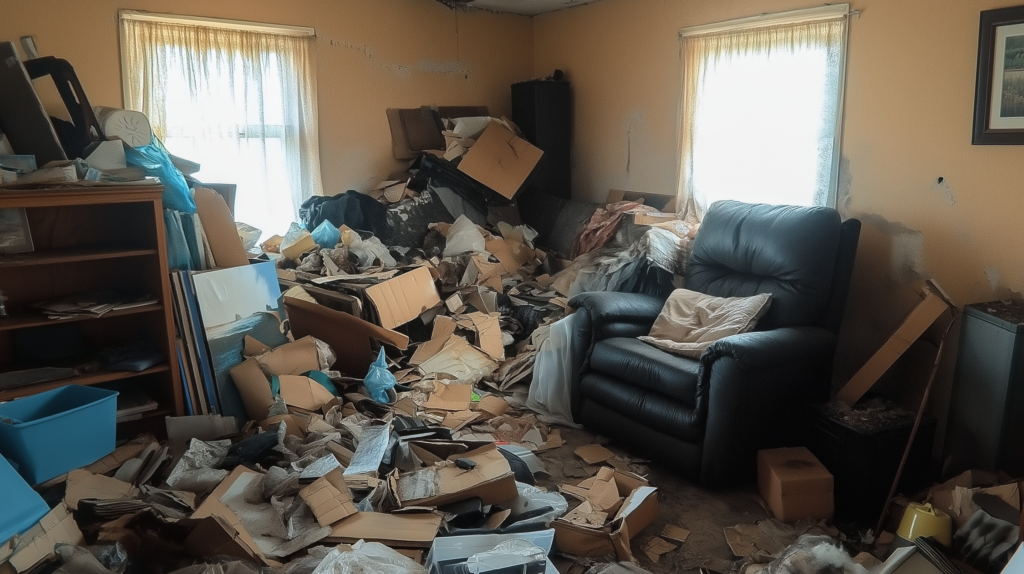Professional Strategies for Restoring Properties Affected by Hoarding
Posted September 10, 2024

Hoarding is a complex issue that restoration contractors often encounter in Canada. It involves the compulsive accumulation of possessions, creating environments that are unsafe, unsanitary, and sometimes structurally compromised. Hoarding can lead to significant health risks, property damage, and emotional distress for those involved, making it a challenging situation for contractors to navigate.
Addressing hoarding as a restoration contractor requires more than just a cleanup—it demands specialized knowledge, a strategic approach, and often collaboration with other professionals. In this blog, we’ll outline the fundamental steps restoration contractors should follow when restoring properties impacted by hoarding.
Understanding Hoarding in Property Restoration
Before diving into the restoration process, it’s crucial to understand hoarding itself. Hoarding Disorder is a psychological condition where individuals struggle to discard possessions, leading to excessive clutter that disrupts the functionality and safety of living spaces. Hoarding can block exits, create fire hazards, encourage mould growth, and lead to structural damage—making properties hazardous for both occupants and restoration teams.
Step 1: Thorough Assessment and Strategic Planning
For restoration contractors, the first step is conducting a comprehensive on-site assessment. This inspection helps evaluate the extent of the hoarding, potential hazards, and any structural damage. Based on the assessment, you can develop a customized cleanup plan that prioritizes safety for both the restoration crew and the property occupants.
Safety is a top priority, as hoarding situations often involve hidden risks like biohazardous materials, mould, and pests. By identifying these dangers upfront, you can put the necessary safety measures in place and ensure your team is properly equipped.
Step 2: Developing a Tailored Cleanup Plan
Every hoarding case is unique, and restoration contractors need to create a tailored cleanup plan for each property. The plan should prioritise high-risk areas, such as blocked exits or unsanitary kitchens and bathrooms, to ensure immediate safety.
In this phase, you’ll need to carefully sort items, separating salvageable belongings from those that must be discarded due to contamination or damage. This process requires sensitivity, as clients may have strong emotional attachments to their possessions.
Step 3: Collaborating with Specialists
Given the emotional and psychological complexities of hoarding, restoration contractors often need to work with mental health professionals or social workers. This collaboration can help ease the client’s stress and facilitate a smoother restoration process.
Additionally, in cases involving biohazards like mould, human waste, or pest infestations, contractors should coordinate with environmental specialists to safely handle these materials in compliance with health and safety regulations.
Step 4: Executing the Cleanup Process
Once the plan is in place, the restoration process begins. Ensure that your crew is equipped with the necessary personal protective equipment (PPE) to safeguard against potential dangers like mould, bacteria, and sharp objects.
Systematic sorting is key. Items are categorised for disposal, recycling, or donation, and specialised disposal services—such as large dumpsters or biohazard removal—may be required for large volumes of waste. Hazards such as chemicals or unsanitary conditions must be handled carefully, ensuring the highest standards of cleanliness are met.
Step 5: Repair and Property Restoration
After decluttering, focus shifts to repairing any damage to the property. Hoarding can cause serious structural damage, including weakened floors, damaged walls, and compromised plumbing or electrical systems. As a restoration contractor, you’ll assess and repair these issues to restore the property to a safe, functional state.
Mould remediation and pest control are often required in hoarding situations. It’s important to also address air quality restoration, including HVAC cleaning and odour removal, to make the property habitable again.
Step 6: Final Walkthrough and Documentation
Once the cleanup and repairs are complete, conduct a final walkthrough with the property owner or their representative. This ensures the work meets their expectations and provides an opportunity to address any remaining concerns.
Detailed documentation is critical, especially when dealing with insurance companies. Provide before-and-after photos, a summary of the work completed, and any relevant reports on biohazard disposal or mould remediation.
Step 7: Follow-Up and Ongoing Support
Hoarding cleanup doesn’t end once the property is restored. Restoration contractors should offer follow-up support, whether through scheduled maintenance cleanings or referrals to mental health professionals for ongoing care.
Providing these services can help prevent recurrence and support the client in maintaining a safe, clutter-free home environment. This step is key to ensuring long-term success for both the property and the individual.
Conclusion: A Professional and Compassionate Approach to Hoarding Restoration
Restoring a hoarding-impacted property is about much more than removing clutter. It’s a highly specialised process that requires attention to safety, respect for the client’s emotional needs, and collaboration with other professionals. By following a structured approach—from assessment and cleanup through to repairs and follow-up—restoration contractors can ensure that properties are safely restored while supporting the well-being of those involved.

